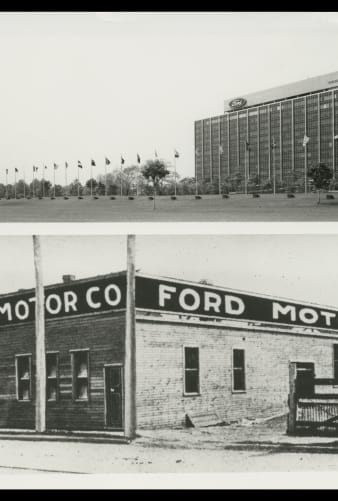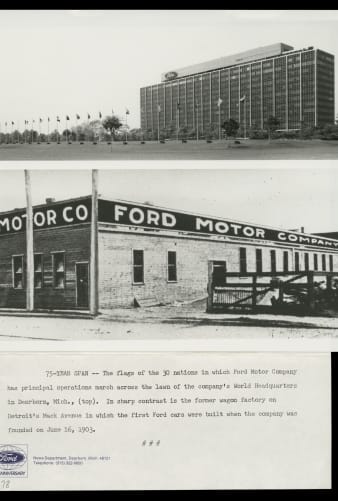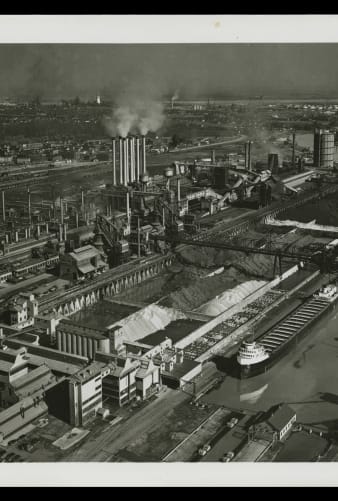
Popular Research Topics
Ford Motor Co. Chronology, 1903-2003
Jun 17, 1903
Ford Motor Company organized, with John S. Gray as President and Henry Ford as Vice President. Stockholders are: Henry Ford, Alexander Malcomson, John W. Anderson, C.H. Bennett, James Couzens, Horace E. Dodge, John F. Dodge, Vernon C. Fry, John S. Gray, Horace H. Rackham, Albert Strelow and Charles J. Woodall.

Jul 23, 1903
Company sells its first car, a two-cylinder Model A, assembled at Mack Avenue Plant in Detroit.
Aug 17, 1904
FMC of Canada, LTD. incorporated near Windsor, Ontario.
Dec 1904
Production begins at Piquette Avenue Plant in Detroit.
Oct 22, 1906
Henry Ford becomes President of Ford Motor Company.
Oct 1, 1908
First Model T made available to the public. Continues until 1927.
Jan 1, 1910
Manufacturing operations transferred to Highland Park, Michigan Plant.
1911
First overseas plant established in Trafford Park, Manchester, England.
Apr 1, 1913
First experiments with assembly line begin at Highland Park Plant. Early trials with assembly of components like magnetos and transmissions are followed by development of chassis assembly line in August 1913.

Jan 12, 1914
$5 daily wage for 8-hour day replaces $2.34 for 9-hour day for male factory workers. Adopted for women workers in Oct 1916.
Dec 10, 1915
1 millionth Ford car produced.
April 1, 1917
Construction begins on Rouge Plant in Dearborn, Michigan.
Jul 2, 1917
First Ford truck introduced, powered by Model T engine.
Oct 1, 1917
Fordson tractor production begins. Only produced in North America until Feb 1928, but continues in Ireland.
Jan 1, 1919
Edsel Ford succeeds his father, Henry Ford, as President. The Fords become sole owners of the company by purchasing stock of the other shareholders.
Feb 4, 1922
Ford Motor Company purchases Lincoln Motor Company for $8 million. Edsel Ford named President of Lincoln.
Jan 15, 1926
Ford Airport dedicated in Dearborn.
May 1, 1926
Five-day, 40-hour work week adopted for factory workers. Adopted for office workers on August 1, 1926.
June 11, 1926
Ford Tri-Motor makes first flight from Ford Airport. Produced until 1933.
May 26, 1927
Model T production ceases.
Nov 1, 1927
Model A production begins. Continues until Feb 28, 1932.
Mar 9, 1932
First Ford V8 en-block engine-equipped car built.
May 26, 1937
"Battle of the Overpass" between UAW organizers and Ford representatives.


Oct 8, 1938
Mercury production begins.
Mar 1, 1941
First jeep produced at Rouge Plant.
Jun 20, 21, 1941
Ford Motor Company signs its first closed-shop contract with UAW-CIO, covering 123,000 employees.
Feb 10, 1942
World War II halts civilian car production.
Nov 28, 1942
First complete bomber, (B-24), built at Willow Run. Production continues through June 28, 1945.
May 26, 1943
Edsel Ford dies at the age of 49. Henry Ford re-elected President of the company.
Jul 3, 1945
Ford passenger car production resumes.
Sep 21, 1945
Edsel Ford's son, Henry Ford II, named President of the company.
Apr 7, 1947
Henry Ford dies at Fair Lane, his Dearborn, Michigan estate, at the age of 83.
Jan 25, 1955
Ernest Breech appointed Chairman.
Jan 17, 1956
Ford Motor Company becomes a publicly-held company with public sale of common stock. Listed on NYSE on Mar 7, 1956.
May 10, 1956
New Ford Motor Company subsidiary, Aeronutronics Systems, established, specializing in defense weapons and aerospace technology.
August 24, 1959
Ford Motor Credit Company formed.
Jul 13, 1960
Ernest Breech resigns as Chairman. Henry Ford II elected Chairman in addition to his Presidency.
Nov 9, 1960
Henry Ford II resigns Presidency and becomes CEO, in addition to remaining Chairman. Robert McNamara becomes President. He resigns Jan 1, 1961 to become Secretary of Defense for John F. Kennedy.
Jan 1, 1961
John Dykstra elected President.
Oct 3, 1961
UAW call first company-wide strike against Ford Motor Company since the first contract was signed in 1941. Strike ends Oct 20 with 3-year agreement.
Dec 11, 1961
Ford Motor Company acquires Philco Corp.
May 1, 1963
Arjay Miller named President.
Sep 6, 1967
UAW calls company-wide strike. Continues until Oct 22, 1967.
Feb 6, 1968
Semon "Bunky" Knudsen named President.
Dec 10, 1970
Lee Iacocca named President. Leaves Ford Motor Company on Oct 15, 1978. Becomes President of Chrysler in Nov 1978.
Oct 1, 1979
Henry Ford II retires as CEO. He retires as Chairman in 1980. Philip Caldwell promoted from Vice Chairman to CEO and President on Oct 1, 1979, and becomes Chairman in 1980. Donald Peterson replaces Caldwell as President and CEO in 1980.
Feb 1, 1985
Philip Caldwell retires and Donald Peterson becomes Chairman. Harold "Red" Poling becomes President.
1986/1987
Ford Motor Company earnings exceed those of General Motors for the first time since 1926.
Sep 29, 1987
Henry Ford II dies.
1987
Ford Motor Company earns record profits, $4.63 billion.
1990
Donald Peterson retires. Harold Poling named new Chairman. Philip Benton named President. The Ford Motor Company acquires Jaguar for $2.5 billion.
1991
Ford Motor Company’s largest 1-year loss ever, $2.3 billion. Ford Motor Company’s QualityCare system is created to meet the diverse “aftersales” needs of private Ford owners and Ford Dealerships. Ford and Volkswagen embark upon a joint venture in “AutoEuropa,” an organization which will produce multipurpose vehicles at Setuba, Portugal.
1992
Ford’s F-Series pickup truck becomes the bestselling vehicle in the United States for its tenth consecutive year. Ford’s Taurus is the first car to have an environmentally friendly air-conditioning system [chlorofluorocarbons (CFC’s) are neither created nor released. Ford Motor Company acquires 50% of Mazda Motor Manufacturing, renaming it AutoAlliance International.
1993
Ford Motor Company is honored to claim five of the eight top selling vehicles in the United States. Ford President Philip Benton, Jr. retires. Alex Trotman, a key player in establishing Ford of Europe, becomes Chairman and CEO of the Ford Motor Company. Almost immediately, Trotman begins efforts to “globalize” the corporation. The first formal Ford Dealerships are placed inside Mainland China. Later, Ford China Operations is created, securing the establishment of manufacturing and assembly centers inside China. Development begins on a marketable natural gas-powered vehicle. Ford Motor Company is the first auto maker to have dual airbags as standard equipment in most of its cars.
1994
The first Ford vehicle assembly begins in India. Ford acquires Hertz, the world’s largest car rental company.
1995
As part of Chairman and CEO Alex Trotman’s plans to “globalize” Ford Motor Company, Ford 2000 is initiated. Ford 2000 will “combine the power, resources, and reach of a world company with the immediacy, intimacy, agility, and spirit of a small one.”
1996
The Ford Motor Company, in keeping with its globalization goals, develops a new family-car designed to fit global needs. In North America, it is marketed as the Ford Contour and Mercury Mystique, while in Europe, Taiwan, and the Middle East, the automobile is the Mondeo. Following the launch of Ford Dealerships inside Russia, a Sales and Marketing Office is sited in Moscow. Ford is the first and only Auto Company to certify all of its plants (140 plants in 26 different countries) under the provisions of ISO 14001—the world environmental standard. The 250 millionth Ford Vehicle is assembled.
1997
Research begun in 1993, leads to the first fleet of natural gas-powered cars to be sold commercially. These automobiles were then marketed to New York City as taxis. The Ford Motor Company creates Visteon Automotive Systems to design, develop, and deliver fully integrated systems for the world market. Ford announces plans to transfer ownership of Budget Rent-A-Car to Team Rental Group.
1998
Stemming from the successful Ford Schools Construction Program, Ford of Mexico’s Quality Education Program begins to provide a myriad of educational and developmental services to students, parents, and teachers. Ford Motor Company and the Mobil Corporation ally in the ongoing search for alternative, and cleaner, fuel sources. Ford reports record $6.9 billion in earnings, thus allowing employees to earn record profit sharing at average of $6,000. Ford’s Taurus takes Winston Cup Victory. With the environment in mind, Ford rallies with Ballard and Daimler-Benz automotive groups to develop fuel-cell technology. Side impact airbags are introduced into Ford’s North American car lineup. The United States Postal Service awards a $206.4 million contract to Ford for 10, 000 “alternative fuel” delivery trucks. Ford teams with the National Aeronautics and Space Administration (NASA) to bring artificial intelligence (AI) into the automobile sector. The AI is designed to improve fuel economy by monitoring fuel combustion rates.
1999
Continuing its quest to globalize, The Ford Motor Company launches IKON, the first car specifically designed for India. Ford’s IKON is assembled at its “state-of-the-art” plant in Marimali Nagar. After six years at Ford, Alex Trotman retires and Jacques Nasser, formerly of Ford Australia and Ford of Europe, becomes President. The Ford Motor Company’s Board of Directors elects William Clay Ford, Jr., a great-grandson of Henry Ford, Chairman of the Board.
Internationally recognized for the highest of safety and quality standards, the Swedish carmaker Volvo becomes a member of the Ford Family for $6.45 billion. To start an automotive e-business integrated supply chain, Ford joins with the Oracle Corporation. Ford seeks the acquisition of 51% interest in Norway’s PIVCO Industries, the maker of TH!NK, a dual seat electric-powered “city car.”
Ford Motor Company combines Aston Martin, Jaguar, Lincoln, and Volvo under the umbrella of the Premier Auto Group. As a companion to QualityCare, Ford purchases the British auto-service chain Kwik-Fit for $1.6 billion. In addition to the certification of its own plants as ISO 14001-friendly, Ford requires all suppliers with manufacturing facilities to adhere to that same standard.
Ford produces the first production vehicle to comply with California’s strict LEV II Emissions Requirements. The Lincoln LS is named Motor Trends’ Car of the Year. The 1914 Ford Model T is named the Car of the Century at a gala event in Las Vegas, Nevada.
2000
At the Oakville, Ontario Ford Facility, Ford of Canada opens the YMCA ChildCare Centre to offer “employees and community residents a state-of-the-art learning environment for preschool children." Ford of Mexico teams up with Mexico’s Environment and Natural Resource Ministry to save Lacandona, the last rainforest in the Northern Hemisphere. Visteon, created in 1998 by Ford Motor Company, becomes an independent organization.
At the North American International Auto Show, Ford officially announces the development of a “family-sized, hybrid-electric vehicle” by 2003.
The Ford Focus is named both the North American Car of the Year and European Car of the Year.
Ford officially takes ownership of LandRover from BMW.
The Ford Motor Company begins the massive re-development of the Rouge Center.
Employees of the Ford Motor Company receive an average of $8,000 in profit sharing for the year of 1999, as well as a home computer, printer, and Internet access.
The Ford Motor Company donates over $18 million to the Detroit Symphony Orchestra, the Detroit Zoo, the Detroit Science Center, the Henry Ford Academy, Princeton University’s Environmental Institute, and the San Diego Environment Foundation.
To streamline global business, Ford, GM, and Daimler Chrysler combine efforts to form a “business to business integrated supplier exchange through a single global router”.
Ford Division Teams with US Auto Dealers and J.D. Power to launch the “Blue Oval” certified program, “the most comprehensive customer satisfaction initiative in automotive retailing”.
Approximately 15,000 “bi-fuel” vehicles roll off of Ford Motor Company’s assembly lines.
2001
Jacques Nasser retires from his position at the Ford Motor Company, leaving William Clay Ford, Jr., the President and CEO.
Ford Motor Company reports 6,991 vehicles sold with $107,064 Million in total revenue.
Ford announces the construction of 6 2003 Model T-100’s (1914 Model T Replicas) for use an April 2003 exhibit at The Henry Ford.
Motor Trend’s names Ford Thunderbird “Car of the Year” for an unprecedented fourth time.
Continuing a trend of increased auto-safety measures, Ford launches “Boost America,” a program which gives away 100,000 booster seats and education on booster seat safety.
The Pacific Basin Economic Council recognizes The Ford Motor Company for its contributions to environment conservation.
2002
The Ford Motor Company announces plans to sponsor the Experimental Aircraft Association’s (E.A.A.) “Countdown to Kitty Hawk,” a commemoration of the 100th anniversary of the Wright Brother’s first powered flight.
2003
In October, Ford unveils a hybridized fuel cell-powered automobile built into the frame of the wildly popular Ford Focus.
The Ford Motor Company celebrates its 100th Anniversary on June 16.
Related Content
Artifacts Related to Ford Chronology
75 Year Span - Ford Motor Company World Headquarters in 1978 - First Factory in 1903
Artifact
Photographic print
Summary
Ford Motor Company's growth from 1903 to 1978 is illustrated by this image. At bottom is the automaker's original single-story factory on Detroit's Mack Avenue. At top is the 12-story Henry Ford II World Center, built in Dearborn in 1953-1956 to house Ford's world headquarters. Ford outgrew Mack Avenue quickly, relocating to a building on Detroit's Piquette Avenue in late 1904.
Keywords
United States, Michigan, Detroit
United States, Michigan, Dearborn
Object ID
84.1.1660.P.O.8504
Credit
From the Collections of The Henry Ford. Gift of Ford Motor Company.
Location
By Request in the Benson Ford Research Center
Get more details in Digital Collections at:
75 Year Span - Ford Motor Company World Headquarters in 1978 - First Factory in 1903
What is The Henry Ford?
The national attraction for discovering your ingenuity while exploring America’s spirit of innovation. There is always much to see and do at The Henry Ford.
Ford Motor Company Employees outside Mack Avenue Plant, Detroit, Michigan, 1903-1904
Artifact
Photographic print
Summary
Ford Motor Company's first plant was a rented former wagon factory on Mack Avenue in Detroit. From 1903 until 1905, this crew of workers assembled Ford automobiles from purchased parts, then inspected, tuned, and prepared each car for shipping. Using this system of small assembly operation, the men produced an average of fifteen finished automobiles each day.
Place of Creation
Object ID
84.1.1660.P.188.1086
Credit
From the Collections of The Henry Ford. Gift of Ford Motor Company.
Location
By Request in the Benson Ford Research Center
Get more details in Digital Collections at:
Ford Motor Company Employees outside Mack Avenue Plant, Detroit, Michigan, 1903-1904
What is The Henry Ford?
The national attraction for discovering your ingenuity while exploring America’s spirit of innovation. There is always much to see and do at The Henry Ford.
Ford Motor Company (Mack Avenue Plant)
Artifact
Factory (Structure)
Date Made
1945
Summary
Henry Ford's third automobile company, formed in 1903, set up shop in a former wagon factory on Detroit's Mack Avenue. Ford's small crew assembled Model A cars from components made elsewhere. Within 18 months, Ford Motor Company moved to a larger facility on Piquette Avenue. This building is a replica about one-fourth the size of the original Mack Avenue plant.
Place of Creation
Keywords
United States, Michigan, Detroit
Reconstructions (Visual works)
Object ID
45.121.1
Credit
From the Collections of The Henry Ford.
Get more details in Digital Collections at:
Ford Motor Company (Mack Avenue Plant)
What is The Henry Ford?
The national attraction for discovering your ingenuity while exploring America’s spirit of innovation. There is always much to see and do at The Henry Ford.
Ford Model A Tudor on Assembly Line, Ford Rouge Plant, Dearborn, Michigan, October 21, 1927
Artifact
Photographic print
Date Made
21 October 1927
Summary
Model A, Ford Motor Company's first all-new car in 19 years, had a difficult birth. Finally conceding to falling sales and pleas from his staff, Henry Ford retired Model T in 1927. Workers and factories sat idle for six months while Ford retooled. But Model A was worth the struggle. It was more advanced, more stylish, and a hit with buyers.
Keywords
Object ID
64.167.833.P.50034
Credit
From the Collections of The Henry Ford. Gift of Ford Motor Company.
Location
By Request in the Benson Ford Research Center
Get more details in Digital Collections at:
Ford Model A Tudor on Assembly Line, Ford Rouge Plant, Dearborn, Michigan, October 21, 1927
What is The Henry Ford?
The national attraction for discovering your ingenuity while exploring America’s spirit of innovation. There is always much to see and do at The Henry Ford.


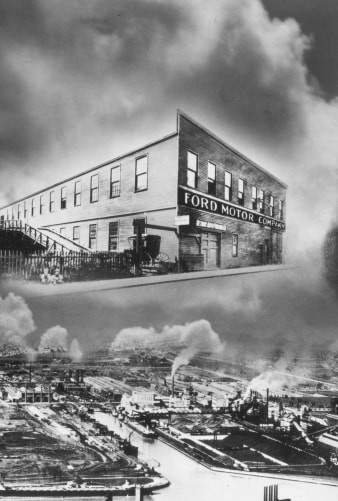
Composite Photograph Showing Henry Ford, Edsel Ford and the Ford Mack Avenue and Rouge Plants, 1934
 Details
Details
Composite Photograph Showing Henry Ford, Edsel Ford and the Ford Mack Avenue and Rouge Plants, 1934
Artifact
Photographic print
Summary
This 1934 composite photo brought together portraits of Henry Ford and Edsel Ford, along with images of two of Ford Motor Company's factories. The Mack Avenue plant was the company's first home, from April 1903 to late 1904. The Rouge factory's first facilities opened in 1917. By 1934 the Rouge was among the largest industrial complexes in the world.
Place of Creation
Keywords
United States, Michigan, Dearborn
United States, Michigan, Detroit
Automobile industry executives
Object ID
P.833.61115
Credit
From the Collections of The Henry Ford. Gift of Ford Motor Company.
Location
By Request in the Benson Ford Research Center
Get more details in Digital Collections at:
Composite Photograph Showing Henry Ford, Edsel Ford and the Ford Mack Avenue and Rouge Plants, 1934
What is The Henry Ford?
The national attraction for discovering your ingenuity while exploring America’s spirit of innovation. There is always much to see and do at The Henry Ford.
Henry Ford, Harry Bennett and Harry Mack at the Willow Run Bomber Plant, 1942
Artifact
Photographic print
Summary
Henry Ford, Harry Bennett, and Harry Mack confer at Ford Motor Company's Willow Run bomber plant in December 1942. Bennett was head of the company's service department and a close confident of Mr. Ford's. Mack was a senior sales executive with the company and a close associate of Bennett's.
Place of Creation
Object ID
64.167.833.P.77289.4
Credit
From the Collections of The Henry Ford. Gift of Ford Motor Company.
Location
By Request in the Benson Ford Research Center
Get more details in Digital Collections at:
Henry Ford, Harry Bennett and Harry Mack at the Willow Run Bomber Plant, 1942
What is The Henry Ford?
The national attraction for discovering your ingenuity while exploring America’s spirit of innovation. There is always much to see and do at The Henry Ford.



Ford Service Department Men Confront UAW UAW Organizers during the Battle of the Overpass, May 26, 1937
 Details
Details
Ford Service Department Men Confront UAW UAW Organizers during the Battle of the Overpass, May 26, 1937
Artifact
Photographic print
Summary
Ford Motor Company refused to recognize the United Auto Workers (UAW) labor union. On May 26, 1937, men from Ford's Service Department (left) attacked labor organizers (right) Robert Kanter, Walter Reuther, Richard Frankensteen, and J.J. Kennedy on a pedestrian overpass at Ford's Rouge Plant. This "Battle of the Overpass" came to symbolize the struggle to unionize Ford. The UAW ultimately succeeded in 1941.
Creators
Keywords
United States, Michigan, Dearborn
Frankensteen, Richard T., 1907-1977
Ford Motor Company. Rouge River Plant
International Union, United Automobile Workers of America (CIO)
Object ID
64.167.833.P.68529.8
Credit
From the Collections of The Henry Ford. Gift of Ford Motor Company.
Location
By Request in the Benson Ford Research Center
Get more details in Digital Collections at:
Ford Service Department Men Confront UAW UAW Organizers during the Battle of the Overpass, May 26, 1937
What is The Henry Ford?
The national attraction for discovering your ingenuity while exploring America’s spirit of innovation. There is always much to see and do at The Henry Ford.


Ford Service Department Men Attack Richard Frankensteen during the Battle of the Overpass, May 26, 1937
 Details
Details
Ford Service Department Men Attack Richard Frankensteen during the Battle of the Overpass, May 26, 1937
Artifact
Photographic print
Summary
Ford Motor Company refused to recognize the United Auto Workers labor union and hired guards to resist unionization among Ford employees. In May 1937, men from Ford's Service Department attacked labor organizers on a pedestrian overpass at Ford's Rouge Plant, beating several men and women. This bloody "Battle of the Overpass" became a lasting symbol of the American labor struggle.
Creators
Keywords
United States, Michigan, Dearborn
Frankensteen, Richard T., 1907-1977
Ford Motor Company. Rouge River Plant
International Union, United Automobile Workers of America (CIO)
Object ID
P.O.5307
Credit
From the Collections of The Henry Ford. Gift of Ford Motor Company.
Location
By Request in the Benson Ford Research Center
Get more details in Digital Collections at:
Ford Service Department Men Attack Richard Frankensteen during the Battle of the Overpass, May 26, 1937
What is The Henry Ford?
The national attraction for discovering your ingenuity while exploring America’s spirit of innovation. There is always much to see and do at The Henry Ford.


Robert Kanter, Richard Frankensteen and Walter Reuther after the Battle of the Overpass, May 26, 1937
 Details
Details
Robert Kanter, Richard Frankensteen and Walter Reuther after the Battle of the Overpass, May 26, 1937
Artifact
Photographic print
Summary
Ford Motor Company refused to recognize the United Auto Workers labor union and hired guards to resist unionization among Ford employees. In May 1937, men from Ford's Service Department attacked labor organizers (including Kanter, Frankensteen and Reuther) on a pedestrian overpass at Ford's Rouge Plant. This bloody "Battle of the Overpass" became a lasting symbol of the American labor struggle.
Keywords
United States, Michigan, Dearborn
Frankensteen, Richard T., 1907-1977
Ford Motor Company. Rouge River Plant
International Union, United Automobile Workers of America (CIO)
Object ID
84.1.1660.P.833.68529.7
Credit
From the Collections of The Henry Ford. Gift of Ford Motor Company.
Location
By Request in the Benson Ford Research Center
Get more details in Digital Collections at:
Robert Kanter, Richard Frankensteen and Walter Reuther after the Battle of the Overpass, May 26, 1937
What is The Henry Ford?
The national attraction for discovering your ingenuity while exploring America’s spirit of innovation. There is always much to see and do at The Henry Ford.
Walter Reuther and Richard Frankensteen after the Battle of the Overpass, May 26, 1937
Artifact
Photographic print
Summary
Ford Motor Company refused to recognize the United Auto Workers labor union and hired guards to resist unionization among Ford employees. In May 1937, men from Ford's Service Department attacked labor organizers (including Reuther and Frankensteen) on a pedestrian overpass at Ford's Rouge Plant. This bloody "Battle of the Overpass" became a lasting symbol of the American labor struggle.
Creators
Keywords
United States, Michigan, Dearborn
Frankensteen, Richard T., 1907-1977
International Union, United Automobile Workers of America (CIO)
Object ID
84.1.1660.P.833.68529
Credit
From the Collections of The Henry Ford. Gift of Ford Motor Company.
Location
By Request in the Benson Ford Research Center
Get more details in Digital Collections at:
Walter Reuther and Richard Frankensteen after the Battle of the Overpass, May 26, 1937
What is The Henry Ford?
The national attraction for discovering your ingenuity while exploring America’s spirit of innovation. There is always much to see and do at The Henry Ford.


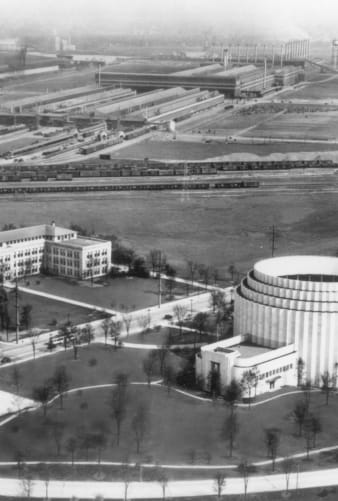
Aerial View of Ford Rotunda, Ford Rouge Plant and Administration Building, Dearborn, Michigan, 1936
 Details
Details
Aerial View of Ford Rotunda, Ford Rouge Plant and Administration Building, Dearborn, Michigan, 1936
Artifact
Photographic print
Summary
The Rotunda was built for the Ford Motor Company exhibition at the 1934 Chicago World's Fair. It was later rebuilt in Dearborn, Michigan, where it served as a hospitality center for tourists from 1936 to 1962. This photograph shows the Rotunda in its second and final home -- across from the Administration Building at Ford's River Rouge Plant.
Place of Creation
Object ID
84.1.1660.P.833.66578
Credit
From the Collections of The Henry Ford. Gift of Ford Motor Company.
Location
By Request in the Benson Ford Research Center
Get more details in Digital Collections at:
Aerial View of Ford Rotunda, Ford Rouge Plant and Administration Building, Dearborn, Michigan, 1936
What is The Henry Ford?
The national attraction for discovering your ingenuity while exploring America’s spirit of innovation. There is always much to see and do at The Henry Ford.
Aerial View of Ford Rouge Plant Complex, 1948
Artifact
Photographic print
Date Made
12 January 1948
Summary
Ford Motor Company built the Rouge Plant with the ability to create automobiles from raw materials. In this photograph, the boat docks and huge coal, iron ore and limestone bins are visible. In 1948, about 850,000 tons of ore and 2,500,000 tons of coal arrived by boat and filled these bins to be used towards building Ford cars.
Place of Creation
Keywords
Object ID
84.1.1660.P.833.85200.2
Credit
From the Collections of The Henry Ford. Gift of Ford Motor Company.
Location
By Request in the Benson Ford Research Center
Get more details in Digital Collections at:
Aerial View of Ford Rouge Plant Complex, 1948
What is The Henry Ford?
The national attraction for discovering your ingenuity while exploring America’s spirit of innovation. There is always much to see and do at The Henry Ford.
Large "Ford" Sign at the Rouge Plant, circa 1964
Artifact
Photographic print
Summary
The River Rouge complex took raw materials, like iron ore, and converted them to refined materials for the creation of new automobiles. Ford strategically positioned the Rouge plant near the river to receive raw materials by boat, and it used the complex's railroad network to distribute them to the proper buildings for refinement. This strategy made Ford Motor Company more efficient and allowed for financial growth.
Place of Creation
Object ID
P.833.135687.95
Credit
From the Collections of The Henry Ford. Gift of Ford Motor Company.
Location
By Request in the Benson Ford Research Center
Get more details in Digital Collections at:
Large "Ford" Sign at the Rouge Plant, circa 1964
What is The Henry Ford?
The national attraction for discovering your ingenuity while exploring America’s spirit of innovation. There is always much to see and do at The Henry Ford.
Oil Painting, Rouge Plant, by Irving R. Bacon, 1949
Artifact
Painting (Visual work)
Date Made
1949
Place of Creation
Keywords
Object ID
00.28.69
Credit
From the Collections of The Henry Ford.
Location
Not on exhibit to the public.
Get more details in Digital Collections at:
Oil Painting, Rouge Plant, by Irving R. Bacon, 1949
What is The Henry Ford?
The national attraction for discovering your ingenuity while exploring America’s spirit of innovation. There is always much to see and do at The Henry Ford.
